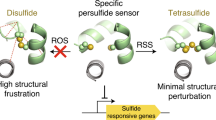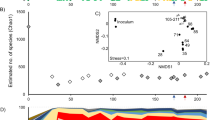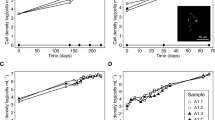Abstract
Inhibitors can be used to control the functionality of microbial communities by targeting specific metabolisms. The targeted inhibition of dissimilatory sulfate reduction limits the generation of toxic and corrosive hydrogen sulfide across several industrial systems. Sulfate-reducing microorganisms (SRM) are specifically inhibited by sulfate analogs, such as perchlorate. Previously, we showed pure culture SRM adaptation to perchlorate stress through mutation of the sulfate adenylyltransferase, a central enzyme in the sulfate reduction pathway. Here, we explored adaptation to perchlorate across unconstrained SRM on a community scale. We followed natural and bio-augmented sulfidogenic communities through serial transfers in increasing concentrations of perchlorate. Our results demonstrated that perchlorate stress altered community structure by initially selecting for innately more resistant strains. Isolation, whole-genome sequencing, and molecular biology techniques allowed us to define subsequent genetic mechanisms of adaptation that arose across the dominant adapting SRM. Changes in the regulation of divalent anion:sodium symporter family transporters led to increased intracellular sulfate to perchlorate ratios, allowing SRM to escape the effects of competitive inhibition. Thus, in contrast to pure-culture results, SRM in communities cope with perchlorate stress via changes in anion transport and its regulation. This highlights the value of probing evolutionary questions in an ecological framework, bridging the gap between ecology, evolution, genomics, and physiology.
Similar content being viewed by others
Log in or create a free account to read this content
Gain free access to this article, as well as selected content from this journal and more on nature.com
or
References
Oremland RS, Capone DG. Use of “ Specific “ inhibitors in biogeochemistry and microbial ecology. Adv Microb Ecol. 1988;10:285–383.
Carlson HK, Mullan MR, Mosqueda LA, Chen S, Arkin MR, Coates JD. High-throughput screening to identify potent and specific inhibitors of microbial sulfate reduction. Environ Sci Technol. 2017;51:7278–85.
Zhu W, Winter MG, Byndloss MX, Spiga L, Duerkop BA, Hughes ER, et al. Precision editing of the gut microbiota ameliorates colitis. Nature. 2018;553:208–11.
Muyzer G, Stams AJM. The ecology and biotechnology of sulphate-reducing bacteria. Nat Rev Microbiol. 2008;6:441–54.
Enning D, Garrelfs J. Corrosion of iron by sulfate-reducing bacteria: New views of an old problem. Appl Environ Microbiol. 2014;80:1226–36.
Postgate J. Competitive inhibition of sulfate reduction by selenate. Nature. 1949;164:670–1.
Postgate BYJR. Competitive and non-competitive inhibitors of bacterial sulphate reduction. J Gen Micriobiol. 1952;6:128–42.
Gieg LM, Jack TR, Foght JM. Biological souring and mitigation in oil reservoirs. Appl Microbiol Biotechnol. 2011;92:263–82.
Carlson HKHK, Kuehl JVJV, Hazra ABAB, Justice NBNB, Stoeva MKMK, Sczesnak A, et al. Mechanisms of direct inhibition of the respiratory sulfate-reduction pathway by (per)chlorate and nitrate. ISME J. 2015;9:1295–305.
Carlson HKHK, Stoeva MKMK, Justice NBNB, Sczesnak A, Mullan MRMR, Mosqueda LALA, et al. Monofluorophosphate is a selective inhibitor of respiratory sulfate-reducing microorganisms. Environ Sci Technol. 2015;49:3727–36.
Engelbrektson A, Hubbard CG, Tom LM, Boussina A, Jin YT, Wong H, et al. Inhibition of microbial sulfate reduction in a flow-through column system by (per)chlorate treatment. Front Microbiol. 2014;5:315.
Cheng Y, Hubbard CG, Li L, Bouskill N, Molins S, Zheng L, et al. Reactive transport model of sulfur cycling as impacted by perchlorate and nitrate treatments. Environ Sci Technol. 2016;50:7010–8.
Hanna E, MacRae IJ, Medina DC, Fisher AJ, Segel IH. ATP sulfurylase from the hyperthermophilic chemolithotroph Aquifex aeolicus. Arch Biochem Biophys. 2002;406:275–88.
Hanna E, Ng KF, MacRae IJ, Bley CJ, Fisher AJ, Segel IH. Kinetic and Stability Properties of Penicillium chrysogenum ATP Sulfurylase missing the C-terminal regulatory domain. J Biol Chem. 2004;279:4415–24.
Kuehl JV, Price MN, Ray J, Wetmore KM, Esquivel Z, Kazakov AE, et al. Functional genomics with a comprehensive library of transposon mutants for the sulfate-reducing bacterium Desulfovibrio alaskensis G20. MBio. 2014;5:1–13.
Christensen GA, Zane GM, Kazakov AE, Li X, Rodionov DA, Novichkov PS, et al. Rex (Encoded by DVU_0916) in Desulfovibrio vulgaris Hildenborough is a repressor of sulfate adenylyl transferase and is regulated by NADH. J Bacteriol. 2015;197:29–39.
Mehta‐Kolte MG, Stoeva MK, Mehra A, Redford SA, Youngblut MD, Zane G, et al. Adaptation of Desulfovibrio alaskensis G20 to perchlorate, a specific inhibitor of sulfate reduction. Environ Microbiol. 2019;21:1395–1406.
Stoeva MK, Nalula G, Garcia N, Yiwei C, Engelbrektson A, Carlson H, et al. Resistance and resilience of sulfidogenic communities in the face of the specific inhibitor perchlorate. Front Microbiol. 2019;10:654.
Elena SF, Lenski RE. Evolution experiments with microorganisms: the dynamics and genetic bases of adaptation. Nat Rev Genet. 2003;4:457–69.
Romero PA, Arnold FH. Exploring protein fitness landscapes by directed evolution. Nat Rev Mol Cell Biol. 2009;10:866–76.
Portnoy VA, Bezdan D, Zengler K. Adaptive laboratory evolution–harnessing the power of biology for metabolic engineering. Curr Opin Biotechnol. 2011;22:590–4.
Mozhayskiy V, Tagkopoulos I. Guided evolution of in silico microbial populations in complex environments accelerates evolutionary rates through a step-wise adaptation. BMC Bioinform. 2012;13:Suppl 10:S10.
Dragosits M, Mattanovich D. Adaptive laboratory evolution – principles and applications for biotechnology. Micro Cell Fact. 2013;12:1–17.
Turcotte MM, Corrin MSC, Johnson MTJ. Adaptive evolution in ecological communities. PLoS Biol. 2012;10:e1001332.
Lawrence D, Fiegna F, Behrends V, Bundy JG, Phillimore AB, Bell T, et al. Species interactions alter evolutionary responses to a novel environment. PLoS Biol. 2012;10:e1001330.
Gómez P, Buckling A. Bacteria-phage antagonistic coevolution in soil. Science. 2011;332:106–9.
Gomez P, Buckling A. Real-time microbial adaptive diversification in soil. Ecol Lett. 2013;16:650–5.
Lenski RE. Experimental evolution and the dynamics of adaptation and genome evolution in microbial populations. ISME J. 2017;11:2181–94.
Engelbrektson AL, Cheng Y, Hubbard CG, Jin YT, Arora B, Tom LM, et al. Attenuating sulfidogenesis in a soured continuous flow column system with perchlorate treatment. Front Microbiol. 2018;9:1575.
Cline JD. Spectrophotometric determination of hydrogen sulfide in natural waters 1. Limnol Oceanogr. 1969;14:454–8.
Widdel F, Bak F. Gram-negative mesophilic sulfate-reducing bacteria. In The Prokaryotes 1992 (pp. 3352–78). Springer, New York, NY.
Keller KL, Rapp-Giles BJ, Semkiw ES, Porat I, Brown SD, Wall JD. New model for electron flow for sulfate reduction in Desulfovibrio alaskensis G20. Appl Environ Microbiol. 2014;80:855–68.
Meyer B, Kuehl JV, Price MN, Ray J, Deutschbauer AM, Arkin AP, et al. The energyconserving electron transfer system used by Desulfovibrio alaskensis strain G20 during pyruvate fermentation involves reduction of endogenously formed fumarate and cytoplasmic and membrane-bound complexes, Hdr-Flox and Rnf. Environ Microbiol. 2014;16:3463–86.
Picelli S, Björklund AK, Reinius B, Sagasser S, Winberg G, Sandberg R. Tn5 transposase and tagmentation procedures for massively scaled sequencing projects. Genome Res. 2014;24:2033–40.
Tjaden B. De novo assembly of bacterial transcriptomes from RNA-seq data. Genome Biol. 2015;16:1–10.
Keller KL, Wall JD, Chhabra S. Methods for engineering sulfate reducing bacteria of the genus Desulfovibrio. In: Methods in enzymology 2011 Jan 1 (Vol. 497, pp. 503–17). Academic Press.
Rahn-Lee L, Byrne ME, Zhang M, Le Sage D, Glenn DR, Milbourne T, et al. A Genetic strategy for probing the functional diversity of magnetosome formation. PLoS Genet. 2015;11:e1004811.
Baba T, Ara T, Hasegawa M, Takai Y, Okumura Y, Baba M, et al. Construction of Escherichia coli K-12 in-frame, single-gene knockout mutants: the Keio collection. Mol Syst Biol. 2006;2:2006.0008.
Jackson WA, Rao B, Sevanthi R, Estrada N, Anderson TA, et al. Global patterns and environmental controls of perchlorate and nitrate co-occurrence in arid and semi-arid environments. Geochim Cosmochim Acta. 2015;164:502–22.
Novichkov PS, Kazakov AE, Ravcheev DA, Leyn SA, Kovaleva GY, Sutormin RA, et al. RegPrecise 3.0 - A resource for genome-scale exploration of transcriptional regulation in bacteria. BMC Genomics. 2013;14:1.
Dehal PS, Joachimiak MP, Price MN, Bates JT, Baumohl JK, Chivian D, et al. MicrobesOnline: an integrated portal for comparative and functional genomics. Nucleic Acids Res. 2010;38:396–400.
Kazakov AE, Rajeev L, Chen A, Luning EG, Dubchak I, Mukhopadhyay A, et al. Sigma(54)-dependent regulome in Desulfovibrio vulgaris Hildenborough. BMC Genomics. 2015;16:1–16.
Lo V, Shao W, Price M. Fitness browser. http://fit.genomics.lbl.gov/cgibin/myFrontPage.cgi. Accessed 9 Dec 2018.
Tarpgaard IH, Jørgensen BB, Kjeldsen KU, Røy H. The marine sulfate reducer Desulfobacterium autotrophicum HRM2 can switch between low and high apparent halfsaturation constants for dissimilatory sulfate reduction. FEMS Microbiol Ecol. 2017;93:1–11.
De Mazancourt C, Johnson E, Barraclough TG. Biodiversity inhibits species’ evolutionary responses to changing environments. Ecol Lett. 2008;11:380–8.
Zhou J, He Q, Hemme CL, Mukhopadhyay A, Hillesland K, Zhou A, et al. How sulphate-reducing microorganisms cope with stress: lessons from systems biology. Nat Rev Microbiol. 2011;9:452–66.
Rajeev L, Luning EG, Altenburg S, Zane GM, Baidoo EEK, Catena M, et al. Identification of a cyclic-di-GMP-modulating response regulator that impacts biofilm formation in a model sulfate reducing bacterium. Front Microbiol. 2014;5:1–13.
Marietou A, Røy H, Jørgensen BB, Kjeldsen KU. Sulfate transporters in dissimilatory sulfate reducing microorganisms: a comparative genomics analysis. Front Microbiol. 2018;9:1–21.
Korte HL, Fels SR, Christensen Ga, Price MN, Kuehl JV, Zane GM, et al. Genetic basis for nitrate resistance in Desulfovibrio strains. Front Microbiol. 2014;5:153.
Kazakov AE, Rajeev L, Luning EG, Zane GM, Siddartha K, Rodionov DA, et al. New family of tungstate-responsive transcriptional regulators in sulfate-reducing bacteria. J Bacteriol. 2013;195:4466–75.
Gisin J, Müller A, Pfänder Y, Leimkühler S, Narberhaus F, Masepohl BA. Rhodobacter capsulatus member of a universal permease family imports molybdate and other oxyanions. J Bacteriol. 2010;192:5943–52.
Hoffmann MC, Pfänder Y, Tintel M, Masepohl B. Bacterial PerO permeases transport sulfate and related oxyanions. J Bacteriol. 2017;199:pii: e00183–17.
Zhou A, Chen YI, Zane GM, He Z, Hemme CL, Joachimiak MP, et al. Functional characterization of Crp/Fnr-type global transcriptional regulators in Desulfovibrio vulgaris Hildenborough. Appl Environ Microbiol. 2012;78:1168–77.
Valette O, Tran TTT, Cavazza C, Caudeville E, Brasseur G, Dolla A, et al. Biochemical Function, molecular structure and evolution of an atypical thioredoxin reductase from Desulfovibrio vulgaris. Front Microbiol. 2017;8:1–16.
Li X, Krumholz LR. Thioredoxin is involved in U(VI) and Cr(VI) reduction in Desulfovibrio desulfuricans G20. J Bacteriol. 2009;191:4924–33.
Zhu L, Gong T, Wood TL, Yamasaki R, Wood TK. σ54-Dependent regulator DVU2956 switches Desulfovibrio vulgaris from biofilm formation to planktonic growth and regulates hydrogen sulfide production. Environ Microbiol. 2019;1462-2920:14679.
Price MN, Ray J, Wetmore KM, Kuehl JV, Bauer S, Deutschbauer AM, et al. The genetic basis of energy conservation in the sulfate-reducing bacterium Desulfovibrio alaskensis G20. Front Microbiol. 2014;5:6–12.
Mukhopadhyay A, Redding AM, Joachimiak MP, Arkin AP, Borglin SE, Dehal PS, et al. Cell-wide responses to low-oxygen exposure in Desulfovibrio vulgaris Hildenborough. J Bacteriol. 2007;189:5996–6010.
Rivas MG, Carepo MSP, Mota CS, Korbas M, Durand MC, Lopes AT, et al. Molybdenum induces the expression of a protein containing a new heterometallic mo-fe cluster in Desulfovibrio alaskensis. Biochemistry. 2009;48:873–82.
He Q, He Z, Joyner DC, Joachimiak M, Price MN, Yang ZK, et al. Impact of elevated nitrate on sulfate-reducing bacteria: a comparative study of Desulfovibrio vulgaris. ISME J. 2010;4:1386–97.
da Silva SM, Amaral C, Neves SS, Santos C, Pimentel C, Rodrigues-Pousada C. An HcpR paralog of Desulfovibrio gigas provides protection against nitrosative stress. FEBS Open Bio. 2015;5:594–604.
Goulian M. Two-component signaling circuit structure and properties. Curr Opin Microbiol. 2010;13:184–9.
Acknowledgements
We would like to thank Andrew Jackson (Texas Tech University) for intracellular sulfate and perchlorate analysis, Grant Zane and the Judy Wall lab (University of Missouri) for discussions regarding overexpression in SRM, Angeliki Marietou (Aarhus University, Denmark) for discussions regarding SRM transporters, Misha Mehta for the FREQseq experiment, Tyler P. Barnum for editing the manuscript and figures, and Anchal Mehra and Nicholas Garcia for general support. Funding support for research on microbial sulfate reduction was generously provided by the Energy Biosciences Institute through their BP research program to JDC. All sequencing data is publicly available under the NCBI BioProject ID PRJNA560652.
Author information
Authors and Affiliations
Corresponding author
Ethics declarations
Conflict of interest
The authors declare that they have no conflict of interest.
Additional information
Publisher’s note Springer Nature remains neutral with regard to jurisdictional claims in published maps and institutional affiliations.
Rights and permissions
About this article
Cite this article
Stoeva, M.K., Kuehl, J., Kazakov, A.E. et al. Anion transport as a target of adaption to perchlorate in sulfate-reducing communities. ISME J 14, 450–462 (2020). https://doi.org/10.1038/s41396-019-0540-7
Received:
Revised:
Accepted:
Published:
Issue date:
DOI: https://doi.org/10.1038/s41396-019-0540-7
This article is cited by
-
Targeting the human gut microbiome with small-molecule inhibitors
Nature Reviews Chemistry (2023)
-
Sulfate adenylyl transferase kinetics and mechanisms of metabolic inhibitors of microbial sulfate respiration
ISME Communications (2021)



